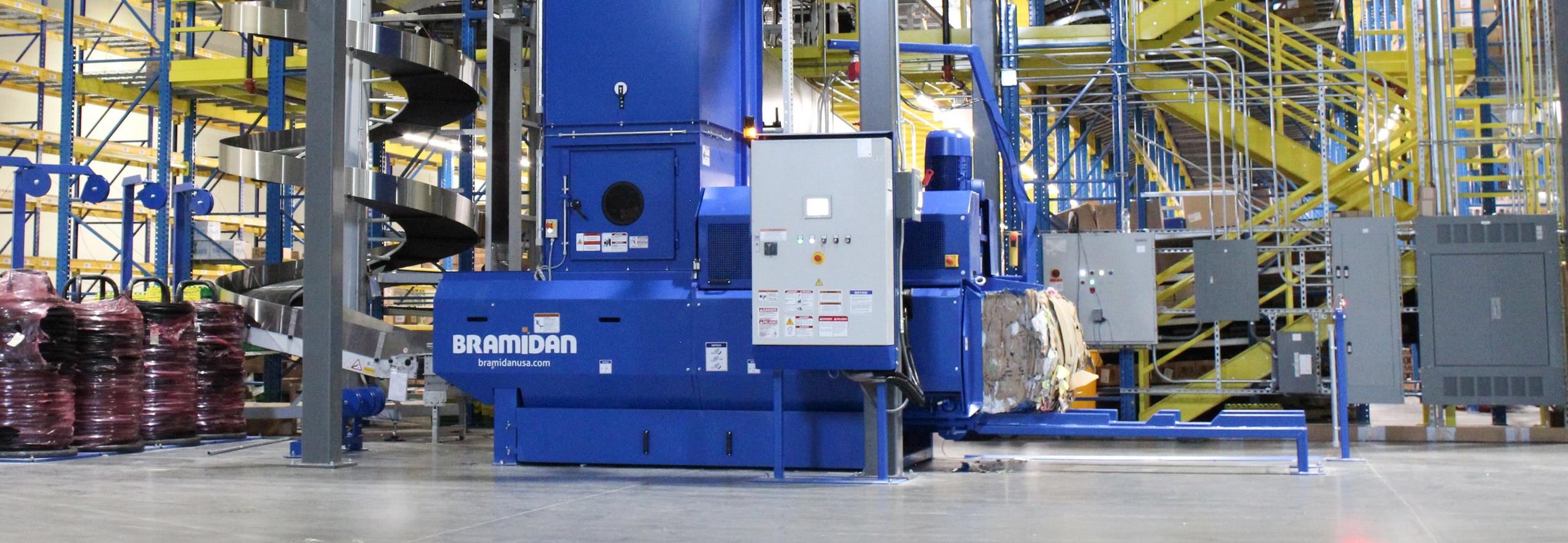
Horizontal Balers For Cardboard, Paper, Plastic, PET and other Post-Production and Packaging Waste
Exploring Horizontal Balers? Let's Find Your Next Machine.
From a compact closed door trim baler to a manual-tie horizontal baler capable of handling multiple materials, we offer a diverse range of solutions to meet the needs of warehouses, distribution centers, and industrial facilities seeking efficiency. Whether it's an open-end auto-tie baler or a robust two-ram horizontal baler for high-volume applications, our lineup caters to your requirements.
Discover Your Perfect Horizontal Baler Match Today.
Closed Door Manual-Tie Balers
CC50 Manual-tie Baler
The CC50 model has a built-in tipping system. This model is recommend for a cardboard. Main product features: closed inlet channel, wide opening, continuous filling. The unit is also available with conveyors, tippers and other accessories. More details…
Bale weight
Cardboard: 1,000-1,200 lbs
Soft plastic/stretch wrap: 1,200-1,400 lbs
BALE SIZE
WxDxH (inch) 60 x 30 x 45
F66 Closed Door Baler
The F66 closed door baler is a multi-material heavy duty, full penetration closed door baler. It has 2 x 6" cylinders in a cross configuration. The opening is 35" x 60" but is also available in a stretch version with a single cylinder and a wider filling opening. Bales are tied manually. More details…
Bale weight
Cardboard: 1,000-1,400 lbs
Soft plastic/stretch wrap: 1,200-1,600 lbs
BALE SIZE
WxDxH (inch) 60 x 30 x 48
Auto-Tie Horizontal Balers
CC40 Auto-tie Baler
High capacity baling solution for compacting large volumes of recyclable waste. Auto-tie stackable bales with the fully-automatic system. Main product features: wide feed opening, flexible loading options, continuous filling, user-friendly interface. More details…
Bale weight
Cardboard: 950-1,100 lbs
Soft plastic/stretch wrap: 1,100-1,300 lbs
BALE SIZE
WxDxH (inch) 60 x 30 x 45
BaleWulf Heavy-Duty Balers
BaleWulf Closed Door Balers
Advanced Closed-Door Solution - Introducing the BaleWulf Closed Door Baler. Versatile and robust, tackling various materials with ease. From everyday recyclables to challenging items. Benefit from top-tier warranties and quality service. Achieve optimal bale weights without straining the baler, ensuring long-lasting performance. More details...
Bale weight
Cardboard: 1,500 lbs
PET: 1,100 lbs
BALE SIZE
WxDxH (inch) 30" x 60" x 48"
BaleWulf TWO RAM Baler
Elevate Recycling Efficiency - Meet the BaleWulf Two Ram Baler. Designed for safety and user-friendliness, it effortlessly handles diverse materials. From OCC and PET to roll cores, tires, and non-ferrous metals. Enjoy unmatched warranties and exceptional service. Achieve target bale weights with minimal stress, ensuring lasting operation. More details...
Bale weight
Cardboard: 1,500 lbs
Mixed Paper: 1,750 lbs
BALE SIZE
WxDxH (inch) 30" x 60" x 45"
Why a horizontal baler?
When a company finds that they have too much recoverable material like cardboard or paper or shrink wrap, they need to find ways to manage it and in an ideal situation profit from it. Options include throwing it all in a trash dumpster, compacting it or baling it. Of these choices baling is the only one that is not a cost generator but is a profit generator.
Hopefully you have had a chance to review our vertical balers and have read the information regarding them.
When the amount of recoverable material exceeds the capacity of a vertical baler, a horizontal baler may be a solution. Volumes over 2 tons per day are the starting point for a small horizontal baler. They should also be considered when labor is less available or when the way of processing the material requires the use of a tipper, conveyor, or other “mass” loading method.
Horizontal balers are larger than verticals and take up more space. They are more expensive and can take a bit more skill to run, but can end up being less labor intensive overall.
Horizontal cardboard balers break out into a few different categories and then branch again from there. We will try to keep the concepts simple.
Large selection of horizontal baler models
These balers, depending on the model, allow you to compact many types of waste. We have various horizontal balers including:
We offer many versions of balers for post-production or packaging waste. They differ, among others, in
Check out how our horizontal balers work
See the videos and find out how easy they are to use
Answer these key questions to determine
which horizontal baler is right for you?
Bramidan offers various types of horizontal balers. How to choose the right model for the needs of your company? The choice depends on several factors.Try to answer these questions to determine what is best, but do not hesitate to contact us for help:
All these questions can lead to different suggestions. For instance, if you are on a steep growth curve, it may be better to go with an auto-tie open end baler than a closed end. They are more expensive, but you would transition into the larger volumes without having to replace the equipment. The fact is, the busier you get, the more difficult the swap out becomes.
Feeding your baler by conveyor may take a good deal of planning within a building whereas a tipper may suffice and not require the floor space. However, you will be trading future convenience and speed for price and space.
Beginning with the end in mind is the bast way to approach a baler purchase. Know what you want to accomplish within a 24–36-month period and then project out 5 years. These are machines that last a long time but are also ones that can be updated when your business changes. It is not unlike buying or designing a home – you really should think about the little things as well as the big things. Buying the wrong machine can be a pain. Buying the right one will feel like a smart investment.
Knowing what your options are is the best course of action and like any big purchase, there are professionals who can help. You can always count on your Bramidan dealer to steer you in the right direction.
Closed end vs. open end - what is the difference?
The fist distinction is “closed end” or “closed-door” balers vs open end balers, sometimes also called extrusion balers.
Closed end balers
Closed end balers are usually used for medium volumes of material and the press forces are typically making bales in the 1,000 lbs to 1,500 lbs range depending on the length and chamber size, cylinder size and other factors.
Additionally, closed end balers are often used when the facility has multiple types of materials to bale, as it is fairly easy to change between materials – for instance cardboard, PET, aluminum cans etc. This is more difficult with an open end baler.
The closed end baler normally pushes out the bales from either the end or the side and generally uses one or two (in a scissor design) cylinder(s).
Open end balers
An open end baler can be a single or dual cylinder and does not typically push against a door, but rather uses a longer chamber with separate hydraulic cylinders that squeeze on the material as it gets pushed through.
Open end balers are also usually auto-tying balers that will tie the bales together automatically; whereas bales made in a closed door baler typically have to be tied manually, by hand.
How does a closed end (door) baler work?
Think of a vertical baler on its back and that is pretty much a horizontal baler.
Some models tie vertically and others horizontally depending on the manufacturer and model.
When the bale has been tied, the front gate or door is opened. This can be done manually or with a hydraulic assist, again depending on options chosen and make and model. The bale is pushed out either by an extending cylinder or by the ram retracting and more material being added until the bale is pushed out.
On average, a closed-end baler generates up to 3 bales per hour and is recommended for processing and compacting low to moderate volumes of cardboard or paper waste, as well as aluminum cans, PET bottles, stretch wrap etc.
After the baling process has been completed, the bale needs to be manually tied off by the operator. The rear or side door (depending on the model and manufacturer) can be opened when finished, so the pressure is released inside the channel. The bale is then pushed out by extending the ram or by the next bale that is in production. This type of baler can be used for single-bale output.

The way the door is configured, how it opens and closes and the way the bale is tied off (which direction – horizontally or vertically) is often different depending on the manufacturer and model. There are manual doors and hydraulically assisted doors.
How is an open-end baler different and when is it used?
Open end balers, sometimes called extrusion balers are uniquely designed to allow for material to be held in place from the sides (squeeze cylinders) rather than by the end of the machine as material passes trough a tensioned channel.
Open end balers are ideal for bulkier materials as well as higher volumes, the open-end baler provides a better flow of materials.
The front of the material bale is pressed up against the previous bale in the chamber, thus acting kind of like a door does in the closed end baler. This process is faster than closed-end balers and also can eliminates the need for other parts such as ejection rams and separation doors.

The tie-off process can be different amongst different manufacturers. Generally speaking, the open-end baler will have an automatic wire tie -off system. These can vary quite a bit, but they all do essentially the same thing in that they tie off the bale at a pre-set size. Photo-eyes and other features can help to keep the size consistent.
Other assisting options can also be employed to keep the bales from deforming or loading unevenly. This is often dependent on the type of material being processed as well as the speed.
Quick guide for picking a baler

VERTICAL 60 INCH BALER
Key - Multi Material, easy to use, affordable
Bale size - 850 lbs – 1,200 lbs
Ave Vol/Mth - 4 tons
Max Vol/Mth - 40 tons
Size - Small (8 foot or less horizontally)
Cost used - $5,000 - $11,000
Cost new - $10,000 - $22,000
Materials - Multiple: OCC, Paper, Film, Sacks
Tie off - Manual
Notes - Lower volume, lower cost, higher labor, easy

CLOSED END BALER
Key - Multi materials, high volume
Bale size - 850 lbs – 1,400 lbs
Ave Vol/Mth - 20 tons +
Max Vol/Mth - 200 tons
Size - Medium footprint (depending on options)
Cost used - $35,000 - $75,000
Cost new - $50,000 - $150,000
Materials - OCC, paper, film PET, Alum/tin cans, etc.
Tie off - Manual (vertical or horizontal dep on mfgs)
Notes - Easier to feed in higher volumes than vertica

SINGLE RAM OPEN END AUTO-TIE
Key - 1 material at a time, high volumes
Bale size - 850 lbs – 2,000 lbs
Ave Vol/Mth - 50 tons +
Max Vol/Mth - 2,000 tons +
Size - Medium to large (dep on mfg & model)
Cost used - $60,000 - $300,000
Cost new - $100,000 - $750,000
Materials - Single stream: OCC, paper, PET, Film (dep mfg)
Tie off - Automatic
Notes - Models differ in kind and volume of material

TWO RAM OPEN END AUTO TIE
Key - Multi Materials and high volumes, dense bales
Bale size - 900 lbs – 2,000 lbs
Ave Vol/Mth - 50 tons +
Max Vol/Mth - 1,000 tons +
Size - Large (L shaped)
Cost used - $150,000 - $750,000
Cost new - $250, 000 - $1M
Materials - All types including non-ferrous metals
Tie off - Automatic
Notes - Multiple materials and high throughput
Single ram or two-ram?
Horizontal balers are usually a single ram (press plate) or twin ram (two press plates). A single ram baler is equipped with one cylinder and a two-ram baler has two cylinders.
Two ram
The two-ram baler is often shaped in an “L” shape so that Ram 1 (the gathering ram) will be the channel where the material is collected and compressed against an end wall.
The other channel (eject ram) is used for pushing the compressed material out of the side to be ejected. Both ram faces perform the compaction, but the second is mostly to push the material sideways and out to be tied-off and the finished bale picked up off a slide or other platform.

The compression force against a surface is greater than that of a single ram where the material is more squeezed in the tensioning walls as it passes through. Hence you get denser bales like a closed door but can process resistant material and more material faster.
Two ram balers are automated versions of closed door balers. They work great for multi material locations, as each bale is finished and kicked out before the next bale is started.
The two ram balers also work great for harder to bale materials such as PET or aluminum cans, as the bales are better contained inside the chamber until the point of tying it together.

Two-Rams are amongst the most versatile balers available and can be adapted with options such as shredders, fluffers and many other modifications that allow for very fast throughput of multiple materials.
The bales tend to be heavier and press forces and cylinder sizes can vary from manufacturer to manufacturer.
The model featured here is made by JWR and Sebright Products. Many European and American manufacturers feature two-ram balers with innovative technologies.
Compact different fractions of waste
Sorting, compacting and recycling waste are important issues that we can help you with. Our horizontal balers can compact many recyclable materials. Here are the main waste fractions that can be compacted in horizontal baler:
Cardboard

Paper

Soft plastic

PET bottles

Tin cans

Alu cans

What materials are baled with a closed end baler?
Cardboard and paper are the most common materials baled in a closed-door baler due to the amount of crush strength needed as well as the expandability of the materials.
Materials that do not take too much pressure to collapse and maintain a shape are best. However, closed end balers are also very useful for multi material applications with harder materials.
Closed door balers are often used in smaller recycling centers and transfer stations, where many different materials are baled every day.
Why invest in horizontal balers for cardboard, soft plastic, stretch wrap and other post-production and packaging waste?
Every horizontal baler in our range is robust and capable of handling heavy loads. Investing in balers for cardboard, PET bottles or compacting other types of recyclables can bring companies many benefits. Our horizontal balers:
What are the main alternatives to horizontal balers?
Since the idea behind a horizontal baler is to allow for more material to be gathered and reduced in size with less labor, auger compactors are sometimes used instead of a horizontal baler.
Auger compactors will compact about 60% more than a standard plunger type of compactor but will be installed outside of the building instead of inside like a baler typically would. This makes the material being recycled worth less money than the baled version since it is less dense and needs to be “hauled” to a site to be recovered and processed.
Auger compactors usually can get 8 – 10 ton of cardboard in a standard 40yard receiver box. With standard heavy duty compactors it can be very difficult to get the material out of the box as the material tends to get jammed. With an auger compactor the material is broken down much better and it will be easier to get the material out.
PRESTO SPN 15
Shown is the PRESTO SPN 15 auger sold by Bramidan USA. Some advantages of this brand are the cooled screw head, sensor lubrication case, direct gear design and a quiet, no hydraulic fluid motor.

Save money and benefit from a monitoring solution for your horizontal baler
With a BRA-IN™ Link you can access your equipment. This means major savings in service and transport.
Your advantages:
Learn more about our BRA-IN monitoring system for your horizontal balers.
Buy or rent?
- Buy - you pay and own it.
- Rent - for a limited period.
You can always combine with service packages for easy administration.

Service & maintenance
The right level of service is key to low operating cost over time.
We recommend that you make a service agreement to protect your investment. Contact us, we offer several service packages.

Who uses our horizontal balers?
Many types of customers, from various industries use our balers to compact waste. They benefit from a Bramidan solution. Find out about our references.

Retail Stores

Distribution & Warehouse

Industry & Manufacturing

Waste Handling Companies
How can I pick the right baler?
Horizontal balers are a capital investment and should be considered carefully at purchase. Finding the right person to help can be tricky. Rely on reliable consultants to select a baler to meet your company's needs.
Any questions? Contact us.
Our sales team is ready to help you
Bramidan US Inc.
Chicago HQ: Addison, Illinois
LA Office: Los Angeles, California

Fill in the form and we will contact you





.png&Format=png&Width=1278&Quality=75)

